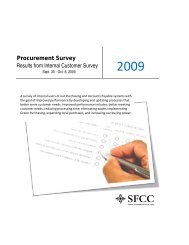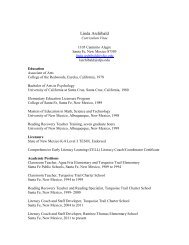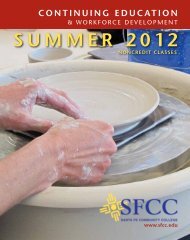2011 Student Writing Awards Booklet - Santa Fe Community College
2011 Student Writing Awards Booklet - Santa Fe Community College
2011 Student Writing Awards Booklet - Santa Fe Community College
You also want an ePaper? Increase the reach of your titles
YUMPU automatically turns print PDFs into web optimized ePapers that Google loves.
unwilling to accept faith. He is neither a nihilist nor a moralist. He recognizes<br />
that grace does subsist but chooses not to accept it (Galloway).We<br />
come to realize that this derelict antagonist actually understands more<br />
about original sin and right and wrong than the grandmother ever has.<br />
Like many of O’Connor’s stories, this one too ends in violence.<br />
Her use of violence is a tool used to strengthen the dramatic effect of<br />
imposing grace on the protagonist.When the grandmother reaches out her<br />
hand to touch her adversary,The Misfit becomes frantic and shoots her<br />
three times in chest. He then utters the most memorable line in the story:<br />
“She would have been a good woman, if it had been somebody there to<br />
shoot her every minute of her life” (O’Connor 236). For the grandmother,<br />
it took death for her to recognize God’s divinity and grace. It was not until<br />
her final judgment hour, seconds from being shot, that she realized the<br />
implications of her pseudo-Christian lifestyle. Even the Misfit, hardly knowing<br />
her, recognizes the grandmother as a fundamentalist charlatan, but that<br />
she has the potential for good just as he does (Renner).The Misfit identifies<br />
the grandmother’s distorted ideology and metaphorically implies that her<br />
potential for good would have been limitless, only if the threat of imminent<br />
death loomed over her as a staunch reminder to “be good or else.”<br />
Since 1955, when “A Good Man is Hard to Find” was first published<br />
as one in a collection of short stories, there has been much discussion<br />
over the true meaning of the story.The answer lies at the poignant<br />
moment when the grandmother’s head clears and she reaches out to touch<br />
The Misfit on the shoulder. As she does this she exclaims,“Why you’re one<br />
of my babies.You’re one of my own children!” (O’Connor 236). It has<br />
been suggested that the grandmother has simply become confused and<br />
mistook The Misfit for her son Bailey, since at this point The Misfit is now<br />
dressed in Bailey’s own shirt (Walters 31). However, I believe this gesture<br />
provides us with a deeper meaning than that. In this moment the grandmother<br />
humbly recognizes that by some ambiguous nature both her and<br />
her enemy are connected. She forfeits all judgment and sees the wayward<br />
Misfit as a fellow child of God.The grandmother is finally ready to accept<br />
her fate and God’s abounding grace.<br />
Flannery O’Connor’s unerring views on religion provide the<br />
backbone for this violent yet thoughtful short story. In her introduction to<br />
“A Memoir of Mary Ann” she wrote,“Most of us have learned to be dispassionate<br />
about evil . . . But good is another matter. <strong>Fe</strong>w have stared at<br />
that long enough to accept the fact that its face too is grotesque, that in us<br />
the good is something under construction” (Ellsberg 142).The grandmother<br />
is sneaky, selfish, and cowardly and is by no means an ideally virtuous<br />
character.What she is though is human. Although we are quick to judge<br />
her character, we have all known someone like her, or perhaps are like her<br />
ourselves. If we let ourselves, we can identify with her weaknesses.Who<br />
54

















